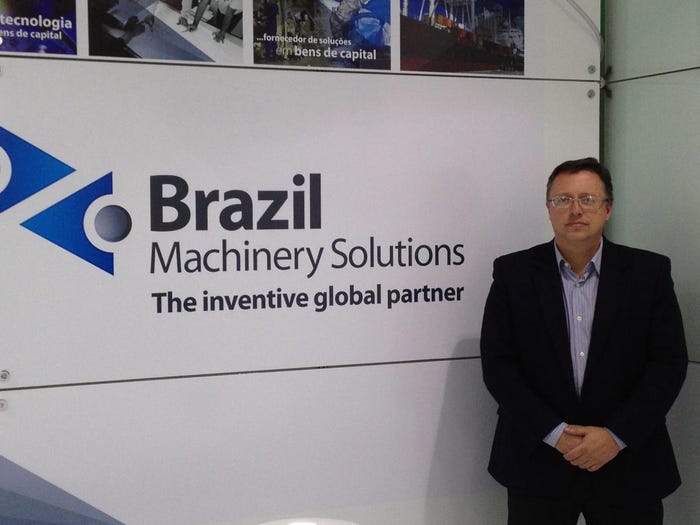Although a stronger real is adding some headwinds, climbing 25% in the last two years, the Brazilian plastics machinery industry continues to see gains in its exports, particularly within Latin America, thanks in large part to an assist from its machinery association and the Brazilian government.
May 22, 2013
Although a stronger real is adding some headwinds, climbing 25% in the last two years, the Brazilian plastics machinery industry continues to see gains in its exports, particularly within Latin America, thanks in large part to an assist from its machinery association and the Brazilian government.
That assist comes in the form of the Brazil Machinery Solutions program, which is a joint effort between the Brazilian Machinery Association (ABIMAQ) and the Brazilian government's export program, APEX. Of the approximately 1500 companies that are in ABIMAQ, 200 participate in Brazil Machinery Solutions, with plastics related machinery being one of 26 subsectors among things like machine tools, textile equipment, and agricultural machinery. Those who have participated have benefited, seeing their exports jump 240% over 5 years, according to ABIMAQ President Klaus Curt Müller. There are 109 ABIMAQ companies at Feiplastic 2013, and of those, 30 are participating in the Brazil Machinery Solutions program.
Seeking new buyers
One such company is Seibt, a 39-yr-old business located in the southernmost state of Brazil, Rio Grande do Sol. Seibt
Kurt Claus Müller |
Kurt Claus Müller, ABIMAQ president. |
manufactures size reduction and plastics recycling equipment, having recently moved into complete washing, drying, and grinding lines for PET. The company sells its equipment throughout Latin America, with some products in Spain and Germany.
Breno Seibt, company director, told PlasticsToday that at this time, about 10% of Seibt's sales come from exports, but the goal is to move that number up to 20 or 30%.
In addition to working with the Brazil Machinery Solutions program, Seibt believes that more stability in the real, should help, even if the currency is higher in value. The company will also be an exhibitor at the K show in Düsseldorf, Germany for the first time this year, hoping to further raise its global profile.
Gino Paulucci Junior, president of Polimáquinas, a São Paulo based manufacturer of film converting equipment, is also a member of ABIMAQ and Brazil Machinery Solutions, seeking greater exports for his 38-yr-old company. His target: the U.S. The company has been exporting equipment for 25 years, including to the U.S., but now Junior says Polimáquinas will be making machines tailored specifically for the American market on the basis of what he views as a shale-gas-fueled leap forward for plastics fabrication in the states. Where countries like Brazil and Mexico import plastics goods into the U.S. today, Junior believes gas at $3-$4 per mmBTU, compared to $12/mmBTU in Brazil, will make the U.S. an exporter once again.
Junior visited NPE2012 to gauge the U.S. market, determining that the market was not yet ready. "We are ready to sell," Junior says, "is the U.S. ready to buy?"
Exports look to rebound after falling in 2012
ABIMAQ's Müller said that as much as possible the goal is to find countries that are good for all ABIMAQ sectors. The Brazil Machinery Solutions branding was created in 2010 to relaunch the program. After developing a list of 44 countries and examining their trade flows in machinery, the group targeted specific nations as potential outlets for Brazilian equipment. These include Argentina, Peru, Colombia, Mexico, U.S., India, South Africa, and Russia, among others.
Since the rebranding, exports of Brazilian machinery jumped 45% from 2010 to 2012 to a value of more than $15 million. The country still ran deficits in equipment trade, which jumped from $13.9 million in 2010 to $150 million in 2011 before falling to $14.9 million in 2012.
Plastics machinery exports jumped from $52.6 million to $97.8 million from 2010 to 2011, before falling in 2012 to $79.5 million in 2012. Imports, which vastly outnumber exports, followed a similar pattern jumping from $565 million to $888 million from 2010 to 2011, before dropping to $669 million in 2012, closing the total plastics machinery trade gap to $589.9 million.
A special program made the Congo the top destination in 2012 with 25% of exports, followed by the U.S. (15%), Mexico (10%), Colombia (8%), Argentina (7%), and Chile (5%).
About the Author(s)
You May Also Like



